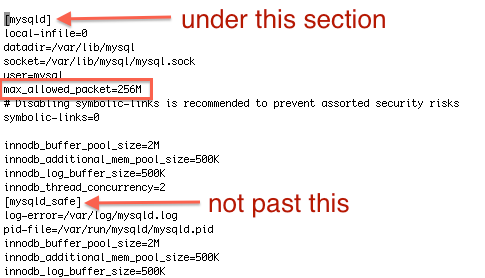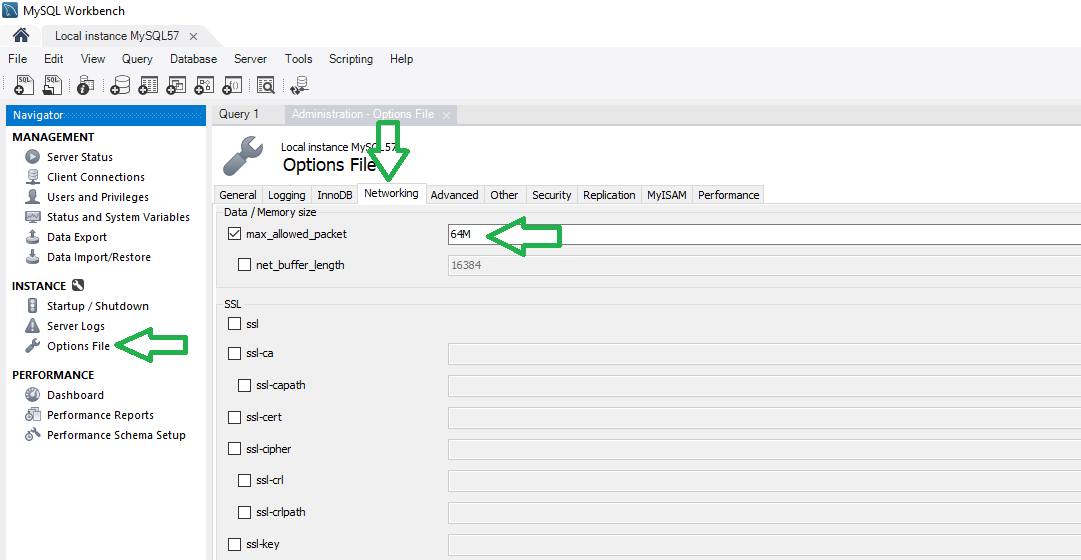Following all instructions, this is what I did and worked:
mysql> SELECT CONNECTION_ID();//This is my ID for this session.
+-----------------+
| CONNECTION_ID() |
+-----------------+
| 20 |
+-----------------+
1 row in set (0.00 sec)
mysql> select @max_allowed_packet //Mysql do not found @max_allowed_packet
+---------------------+
| @max_allowed_packet |
+---------------------+
| NULL |
+---------------------+
1 row in set (0.00 sec)
mysql> Select @@global.max_allowed_packet; //That is better... I have max_allowed_packet=32M inside my.ini
+-----------------------------+
| @@global.max_allowed_packet |
+-----------------------------+
| 33554432 |
+-----------------------------+
1 row in set (0.00 sec)
mysql> **SET GLOBAL max_allowed_packet=1073741824**; //Now I'm changing the value.
Query OK, 0 rows affected (0.00 sec)
mysql> select @max_allowed_packet; //Mysql not found @max_allowed_packet
+---------------------+
| @max_allowed_packet |
+---------------------+
| NULL |
+---------------------+
1 row in set (0.00 sec)
mysql> Select @@global.max_allowed_packet;//The new value. And I still have max_allowed_packet=32M inisde my.ini
+-----------------------------+
| @@global.max_allowed_packet |
+-----------------------------+
| 1073741824 |
+-----------------------------+
1 row in set (0.00 sec)
So, as we can see, the max_allowed_packet has been changed outside from my.ini.
Lets leave the session and check again:
mysql> exit
Bye
C:\Windows\System32>mysql -uroot -pPassword
Warning: Using a password on the command line interface can be insecure.
Welcome to the MySQL monitor. Commands end with ; or \g.
Your MySQL connection id is 21
Server version: 5.6.26-log MySQL Community Server (GPL)
Copyright (c) 2000, 2015, Oracle and/or its affiliates. All rights reserved.
Oracle is a registered trademark of Oracle Corporation and/or its
affiliates. Other names may be trademarks of their respective
owners.
Type 'help;' or '\h' for help. Type '\c' to clear the current input statement.
mysql> SELECT CONNECTION_ID();//This is my ID for this session.
+-----------------+
| CONNECTION_ID() |
+-----------------+
| 21 |
+-----------------+
1 row in set (0.00 sec)
mysql> Select @@global.max_allowed_packet;//The new value still here and And I still have max_allowed_packet=32M inisde my.ini
+-----------------------------+
| @@global.max_allowed_packet |
+-----------------------------+
| 1073741824 |
+-----------------------------+
1 row in set (0.00 sec)
Now I will stop the server
2016-02-03 10:28:30 - Server is stopped
mysql> SELECT CONNECTION_ID();
ERROR 2013 (HY000): Lost connection to MySQL server during query
Now I will start the server
2016-02-03 10:31:54 - Server is running
C:\Windows\System32>mysql -uroot -pPassword
Warning: Using a password on the command line interface can be insecure.
Welcome to the MySQL monitor. Commands end with ; or \g.
Your MySQL connection id is 9
Server version: 5.6.26-log MySQL Community Server (GPL)
Copyright (c) 2000, 2015, Oracle and/or its affiliates. All rights reserved.
Oracle is a registered trademark of Oracle Corporation and/or its
affiliates. Other names may be trademarks of their respective
owners.
Type 'help;' or '\h' for help. Type '\c' to clear the current input statement.
mysql> SELECT CONNECTION_ID();
+-----------------+
| CONNECTION_ID() |
+-----------------+
| 9 |
+-----------------+
1 row in set (0.00 sec)
mysql> Select @@global.max_allowed_packet;//The previous new value has gone. Now I see what I have inside my.ini again.
+-----------------------------+
| @@global.max_allowed_packet |
+-----------------------------+
| 33554432 |
+-----------------------------+
1 row in set (0.00 sec)
Conclusion, after SET GLOBAL max_allowed_packet=1073741824, the server will have the new max_allowed_packet until it is restarted, as someone stated previously.


